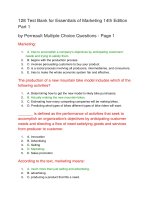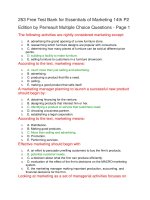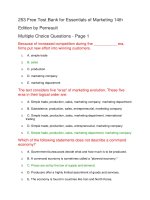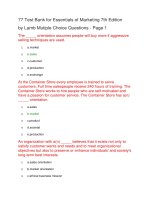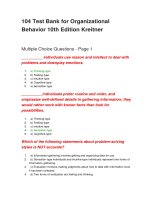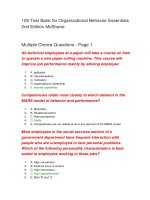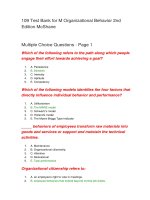132 test bank for essentials of organizational behavior 11th edition robbins đề thi trắc nghiệm
Bạn đang xem bản rút gọn của tài liệu. Xem và tải ngay bản đầy đủ của tài liệu tại đây (211.81 KB, 37 trang )
132 Test Bank for Essentials of Organizational
Behavior 11th Edition Robbins
Multiple Choice Questions - Page 1
Neville feels obligated to remain with his company on account of the
resources they have invested in training him. This example is indicative of
________.
1.
A) normative commitment
2.
B) continuance commitment
3.
C) affective commitment
4.
D) positive commitment
5.
E) negative commitment
Job satisfaction is best described as ________.
1.
A) a result
2.
B) a value
3.
C) an attitude
4.
D) causing high performance
5.
E) a valued discipline
Jo is a courier, delivering parcels throughout the metropolitan area.
Although she considers herself law abiding, she often breaks the speed
limit while making her deliveries. Which of the following statements does
not reflect a likely response to the conflict between her attitude and her
behavior?
1.
A) "It's not a problem that I speed a little bit; it's not much over the limit, and
everyone else speeds some."
2.
B) "The speed limits are just too low around here; anyone driving at a reasonable
speed will break them."
3.
C) "This speeding is irresponsible. From now on I am observing the speed limits."
4.
D) "I've got to drive fast sometimes, otherwise I will not make all my deliveries and
I'll lose clients."
5.
E) "It's wrong to break even minor laws, but I'll probably keep speeding anyway."
Which of the following is an example of an affective attitude?
1.
A) Believing that you did a good job.
2.
B) The observation that most dogs have four legs.
3.
C) The opinion that it is never acceptable to steal.
4.
D) Anger at being unfairly accused of a wrongdoing.
5.
E) The avoidance of a restaurant where one once received bad service.
Jan is a security officer. Jan believes that it is important to know exactly
who is in the office at any given time. She notices that some employees
do not sign out of the office when they take lunch, which makes it
impossible to keep track of who is actually in the office. Jan becomes
frustrated with those employees. She makes note of them and reports
them to their supervisors. In the above scenario, what is the behavioral
component of Jan's attitude to the employees who did not sign out of the
office?
1.
A) Jan believes that it is important that she know exactly who is in the office at any
given time.
2.
B) Jan does not like that some employees do not sign out of the office when they
take lunch.
3.
C) Jan finds it impossible to keep track of who is actually in the office.
4.
D) Jan becomes frustrated with those employees who do not sign out of the office.
5.
E) Jan notes which employees leave the office without signing out, and reports
them to their supervisors.
The degree to which a person identifies with his or her job, actively
participates in it, and considers his or her performance as being important
to self-worth is ________.
1.
A) job satisfaction
2.
B) job involvement
3.
C) job stability
4.
D) organizational commitment
5.
E) social embeddedness
The theory of cognitive dissonance was proposed by ________.
1.
A) Maslow
2.
B) Festinger
3.
C) Hofstede
4.
D) Skinner
5.
E) Pavlov
The following answer choices are quotes from employees about their job
at Healthy Eating, a chain of health food stores. Which quote most likely
comes from an employee who has a great deal of organizational
commitment?
1.
A) "I am a great believer in the importance of a healthy diet, so I'm glad I am
working for a company that is trying to make simple, healthy food available to all."
2.
B) "I like the fact that in my role as a buyer for Healthy Eating I get to make
choices about which food is good enough for us to sell."
3.
C) "Even though I only work in the produce department for now, it's good to know
that the suggestions I make about how the store could be improved are heard and
considered by my managers."
4.
D) "The challenging nature of the work and the thoughtful and generous way they
treat their staff has made Healthy Eating the best place I have ever worked."
5.
E) "With the benefits it provides, it is vital for me to keep my job. In fact, I will stay
with Healthy Eating for as long as I possibly can."
It is safe to say that this wouldn't be a problem if Mrs. Jonas was
________.
1.
A) a worker rather than a supervisor
2.
B) working for the construction company
3.
C) more of an ethical character
4.
D) an undocumented worker
5.
E) indifferent to workers' rights
Which of the following is not considered a major job attitude by OB
researchers?
1.
A) job satisfaction
2.
B) positive personality
3.
C) organizational commitment
4.
D) employee engagement
5.
E) job involvement
Which of the following answer choices is the best definition of attitude?
1.
A) Attitudes indicate how one will react to a given event.
2.
B) Attitudes are the yardstick by which one measures ones actions.
3.
C) Attitudes are the emotional part of an evaluation of a person, object, or event.
4.
D) Attitudes are evaluative statements of what one believes about something or
someone.
5.
E) Attitudes are a measure of how the worth of an object, person or event is
evaluated.
The emotional, or feeling component of a person's attitude is called
________.
1.
A) complex understanding
2.
B) the cognitive component
3.
C) the affective component
4.
D) a complex attitude
5.
E) the behavior component
What refers to a positive feeling about a job, resulting from an evaluation
of its characteristics?
1.
A) job satisfaction
2.
B) job involvement
3.
C) job stability
4.
D) organizational commitment
5.
E) social investment
Leon Festinger argued that ________ follow(s) ________.
1.
A) behavior; job satisfaction
2.
B) behavior; attitude
3.
C) attitudes; behavior
4.
D) attitudes; job satisfaction
5.
E) job satisfaction; behavior
"Dissonance" means ________.
1.
A) reactance
2.
B) constance
3.
C) resistance
4.
D) consistency
5.
E) inconsistency
Any incompatibility between two or more attitudes or between behavior
and attitudes results in ________.
1.
A) organizational dissonance
2.
B) cognitive dissonance
3.
C) attitudinal clarification
4.
D) values clarification
5.
E) affective reactance
Organizational commitment is defined as ________.
1.
A) the degree to which an employee identifies with the organization they work for
and its goals
2.
B) an employee's belief that the organization they work for will go to considerable
lengths to ensure that its employees are treated fairly
3.
C) the degree to which an employee's sense of fulfillment and self worth is related
to their job
4.
D) the amount of effort an employee will make in order to keep or advance their
position in an organization
5.
E) the degree to which an employee believes their work impacts their organization
According to Festinger, people will seek a(n) ________.
1.
A) variable state with variable dissonance
2.
B) stable state with maximal dissonance
3.
C) unstable state with maximal dissonance
4.
D) unstable state with minimal dissonance
5.
E) stable state with minimal dissonance
In this situation Mrs. Jonas has a(n) ________ that is in conflict with a(n)
________.
1.
A) behavior; behavior
2.
B) attitude; attitude
3.
C) social need; social interest
4.
D) social need; social need
5.
E) attitude; behavior
Festinger argued that dissonance is ________. Therefore, people will
attempt to reduce it.
1.
A) monotonous
2.
B) confounding
3.
C) physically painful
4.
D) exhausting
5.
E) uncomfortable
Janice is spending the summer working as an intern writing copy for a
local firm. Today Janice's senior editor sent back some of Janice's work
covered in red ink corrections. Up until now, all of Janice's work had been
corrected in green or blue ink. Janice is upset and worried that her senior
editor doesn't like her. Which component of an attitude is not represented
in the previous scenario?
1.
A) the positive component
2.
B) the cognitive component
3.
C) the affective component
4.
D) the negative component
5.
E) the behavioral component
Which dimension of organizational commitment describes an employee
who is "tethered" to an employer simply because there isn't anything
better available?
1.
A) general organizational commitment
2.
B) affective commitment
3.
C) normative commitment
4.
D) continuance commitment
5.
E) incremental commitment
The belief that "violence is wrong" is an evaluative statement. Such an
opinion constitutes the ________ component of an attitude.
1.
A) cognitive
2.
B) affective
3.
C) reflective
4.
D) behavioral
5.
E) reactive
Guillermo's wife was recently diagnosed with breast cancer. Guillermo
had to take a considerable amount of time off work to care for their
children, and he was late in completing his portion of a large project.
Guillermo never feared that his job was in jeopardy because of his
absences or his delay in completion of work. Name the major job attitude
relative to the above stated example.
1.
A) psychological empowerment
2.
B) perceived organizational support
3.
C) organizational commitment
4.
D) employee engagement
5.
E) job involvement
In her work in the publishing industry, Vera seeks out new authors who
she considers promising. In the past two years she has found a number of
new writers whose work she thought was exceptional, and immersed
herself in the task of helping them shape their manuscripts for
submission to her managers for publishing. Although she was extremely
proud of the results, none of the authors she worked with were chosen for
publication. Vera believes that the decision not to publish these authors
was based on personal
1.
A) low job satisfaction and low job involvement
2.
B) low job satisfaction and high job involvement
3.
C) high job satisfaction and low job involvement
4.
D) high job satisfaction and high job involvement
5.
E) low organizational commitment
Which dimension to organizational commitment is reflected in the
perceived economic value of remaining with an organization compared to
leaving it?
1.
A) general organizational commitment
2.
B) affective commitment
3.
C) continuance commitment
4.
D) normative commitment
5.
E) incremental commitment
Mrs. Jonas can be expected to relieve the discomfort she is experiencing
by doing the following except ________.
1.
A) deciding this issue is unimportant
2.
B) rationalizing that it is not her problem since she is not the contractor
3.
C) attempting to stop the contractor using undocumented workers
4.
5.
D) coming to accept that using undocumented workers does not harm workers'
rights
E) terminating the contract as it is against her attitude
Bryan Eusebius has a positive attitude toward his organization. He feels
the management treats all employees fairly in matters concerning
rewards, takes into account employees' opinions, and overall, is highly
supportive. Bryan's attitude toward his employing organization is
indicative of ________.
1.
A) psychological empowerment
2.
B) employee engagement
3.
C) perceived organizational support
4.
D) core self evaluations
5.
E) organizational citizenship
Sheila works for a manufacturer of styrofoam trays for school lunches.
Last year her son came home from school and told her that the trays she
makes go straight to the landfill where they sit for hundreds of years
without ever biodegrading. Although this information bothers Sheila, she
does not look for another job because she enjoys her very high salary.
Which dissonance moderating factor is illustrated by this example?
1.
A) Dissonance is reduced because of the sense of control by the individual.
2.
B) Dissonance is reduced because of the importance to the individual.
3.
C) There is no dissonance moderating factor in the example.
4.
D) Dissonance is increased because of the sense of control by the individual.
5.
E) High dissonance is tolerated because of a high reward.
Employees' beliefs in the degree to which they influence their work
environment, their competence, the meaningfulness of their job, and their
perceived autonomy is termed as ________.
1.
A) psychological empowerment
2.
B) organizational commitment
3.
C) perceived organizational support
4.
D) employee engagement
5.
E) job satisfaction
Which of the following is not a moderating variable of the attitudebehavior relationship?
1.
A) direct experience
2.
B) correspondence to behavior
3.
C) power
4.
D) accessibility
5.
E) importance
Festinger proposed that the desire to reduce dissonance is determined by
three moderating factors including the ________.
1.
A) values of the elements creating the dissonance
2.
B) degree of influence the individual believes he or she has over the elements
3.
C) degree of positive affect the person has toward the behavior
4.
D) fact that values and attitudes will vary over the short term
5.
E) awareness that dissonance exists
Mrs. Jonas is likely experiencing ________.
1.
A) cognitive dissonance
2.
B) unresolved anger
3.
C) ethical evasion
4.
D) uncertainty avoidance
5.
E) social pressure
The attitude-behavior relationship is likely to be much stronger if the
attitude ________.
1.
A) refers to something that the individual has direct personal experience with
2.
B) must be defended against the attitudes of society at large
3.
C) is perceived to be of little importance
4.
D) is related to organizational structure
5.
E) is not regularly discussed and examined
Mrs. Jonas comes to you for an explanation of why she is so
uncomfortable. You would refer her to the theories of ________.
1.
A) Hofstede
2.
B) Maslow
3.
C) Skinner
4.
D) Festinger
5.
E) Surber
________ is an emotional attachment to the organization and a belief in its
values.
1.
A) Affective commitment
2.
B) Continuance commitment
3.
C) Normative commitment
4.
D) Positive commitment
5.
E) Negative commitment
Of the following attitudes, the best predictor of turnover is ________.
1.
A) pay
2.
B) supervision
3.
C) organizational commitment
4.
D) cognitive dissonance
5.
E) affective dissonance
________ is an obligation to remain with the organization for moral or
ethical reasons.
1.
A) Negative commitment
2.
B) Positive commitment
3.
C) Affective commitment
4.
D) Normative commitment
5.
E) Continuance commitment
Jane is committed to her employer because she is paid well and feels it
would hurt her family to quit. This is indicative of ________.
1.
A) affective commitment
2.
B) normative commitment
3.
C) continuance commitment
4.
D) positive commitment
5.
E) negative commitment
Cameron loves her job as a data programmer, but her co-worker Blake, is
very challenging. Blake often loses his temper over aspects of shared
projects that neither of them can control. When discussing projects in
Cameron's work station, Blake plays with her office supplies, rearranges
her desk, and leaves snack and food crumbs. Worst of all, Blake always
takes the portion of a project that is the easiest, leaving Cameron to work
harder and longer hours. Which of the following is not an effective method
for
1.
A) Cameron should invite Blake to lunch and directly confront him with her
feelings.
2.
B) Cameron should invite Blake to coffee to clarify if there are any
misunderstandings.
3.
C) Cameron should simply ignore Blake and his behavior.
4.
D) Cameron should make a point of going to Blake's work station and leaving a
mess.
5.
E) Cameron should ask a manager to help divide the work load for the next
project.
________ is the degree to which employees believe the organization
values their contribution and cares about their well-being.
1.
A) Psychological empowerment
2.
B) Employee engagement
3.
C) Perceived organizational support
4.
D) Organizational commitment
5.
E) Job involvement
86 Free Test Bank for Essentials of Organizational
Behavior 11th Edition Robbins Multiple Choice
Questions - Page 2
The exit–voice–loyalty–neglect framework expands employee response to
include voice and loyalty—constructive behaviors that allow individuals to
________.
1.
A) revolt against the management
2.
B) reject unionization and focus on external activities
3.
C) identify psychologically with their jobs
4.
D) tolerate unpleasant situations or revive satisfactory working conditions
5.
E) improve their perceptions of organizational support
To get his company through some hard economic times, Ben's hours have
just been reduced from 40 a week to 33. Ben is upset about the reduction
in time and pay, but he shows up at work every morning and is willing to
patiently wait until economic times improve, and he can go back to
working full time. Which of the following best describes Ben's response to
his dissatisfaction?
1.
A) active, constructive, voice
2.
B) passive, destructive, neglect
3.
C) passive, constructive, loyal
4.
D) active, destructive, exit
5.
E) active, constructive, loyal
Maria is dissatisfied with the way that her manager treats her. She has quit
her job and found a new position with another firm. She has expressed
her dissatisfaction through ________.
1.
A) exit
2.
B) voice
3.
C) loyalty
4.
D) neglect
5.
E) social voice
Why should managers be interested in their employees' attitudes?
1.
A) They result from behavior.
2.
B) They cause problems.
3.
C) They give warnings of potential problems.
4.
D) They are generally low.
5.
E) They result in cognitive dissonance.
Jason has been spending a great deal of work time talking to his coworkers about how dissatisfied he is with the job. He has spent quite a bit
of time discussing unionization. Jason has also arrived at work
intoxicated twice in the last week and has repeatedly taken office supplies
home with him. His behavior might be classified as ________.
1.
A) job enlargement
2.
B) deviant behavior
3.
C) separation anticipation
4.
D) theft
5.
E) cognitive dissonance
Attending union meetings as a way of coping with job dissatisfaction
would be what type of response?
1.
A) exit
2.
B) voice
3.
C) loyalty
4.
D) neglect
5.
E) reification
Toni has decided that she'll just get a new job and get away from the
problem. Toni is dealing with her dissatisfaction through ________.
1.
A) exit
2.
B) voice
3.
C) loyalty
4.
D) neglect
5.
E) acceptance
Joe is dissatisfied with his job and deals with it by regularly discussing
his problems with his manager. Which type of response is Joe using in
this situation?
1.
A) exit
2.
B) voice
3.
C) loyalty
4.
D) neglect
5.
E) performance
Job dissatisfaction is more likely to translate into ________ when
employees feel or perceive they have many available alternatives. This
can happen when employees have high human capital.
1.
A) neglect
2.
B) engagement
3.
C) tardiness
4.
D) turnover
5.
E) absenteeism
Dispatch Heroes Inc. is a medium-sized logistics company. The
management is facing tough times as the workers are dissatisfied and are
engaging in a number of deviant workplace behaviors such as stealing,
undue socializing, and tardiness. The management is considering
enforcing several rules restrictions to curb these counterproductive
behaviors. What would be a better way to deal with such forms of
workplace deviance?
1.
A) Employers must take corrective action to stop the unwanted activities.
2.
B) Employers should attack the source of the problem, i.e. the dissatisfaction.
3.
C) Employers must introduce survellience to ensure smooth flow of work.
4.
D) The management must suspend employees who engage in deviant workplace
behaviors.
5.
E) The management must restrict the activities that adversely affect productivity.
Compared to people who have a negative core self-evaluation, people who
have a positive core self-evaluation ________.
1.
A) are less satisfied with their jobs
2.
B) see their work as less challenging
3.
C) see their work as less fulfilling
4.
D) are less likely to gravitate toward challenging jobs
5.
E) are less likely to give up when confronting difficulties
Which of the following is the best method for measuring job satisfaction?
1.
A) a single global rating system of 1 to 5 (highly satisfied to highly dissatisfied)
2.
B) the summation of satisfaction of various job facets to reveal an overall score
3.
C) job satisfaction is too broad of a term and there is no good way to measure it
4.
D) the single global rating system and the job facets score are equally accurate
5.
E) the length of time an employee stays on the job and is engaged
Mark believes that his manager is a good person and will work things out
if Mark just gives him time to do so. Mark is dealing with his
dissatisfaction through ________.
1.
A) exit
2.
B) voice
3.
C) loyalty
4.
D) neglect
5.
E) acceptance
Which of the following statements is true about measuring job
satisfaction?
1.
2.
3.
4.
5.
A) The simplistic approach of the single global rating system leads to greater
inaccuracies.
B) The single global rating method isn't very time consuming.
C) Problem identification and resolution takes more time with the summation of job
facets method.
D) The essence of satisfaction cannot be captured through a single question.
E) The more complex and intricate the measurement method, the better the
results.
Henry is dissatisfied with his job but believes that his supervisor is a good
man who will do the right thing. Henry has decided that if he just waits,
conditions will improve. Henry's approach to this problem is termed
________.
1.
A) exit
2.
B) voice
3.
C) loyalty
4.
D) neglect
5.
E) reification
Susan has composed a list of concerns along with her suggestions for
improving conditions. Susan is dealing with her dissatisfaction through
________.
1.
A) exit
2.
B) voice
3.
C) loyalty
4.
D) neglect
5.
E) acceptance
An individual's involvement with, satisfaction with, and enthusiasm for the
work he/she performs is known as ________.
1.
A) employee engagement
2.
B) job involvement
3.
C) loyalty
4.
D) job satisfaction
5.
E) psychological empowerment
Ang is very satisfied with his job. On a scale of 1 to 10 he rated his job
satisfaction at nearly six. Based on his job satisfaction rating, in which of
the following countries is Ang least likely to work?
1.
A) Sweden
2.
B) U.S.A.
3.
C) Denmark
4.
D) Germany
5.
E) Japan
Which of the following is true regarding the relationship between
satisfaction and absenteeism?
1.
A) There is a consistent positive relationship between the two.
2.
B) There is a consistent negative relationship between the two.
3.
C) There is a curvilinear relationship between the two.
4.
D) When fairness is controlled for, there is a direct relationship between the two.
5.
E) No relationship can be established between the two.
Which major job-satisfaction facet is most strongly correlated with high
levels of overall job satisfaction?
1.
A) work flexibility
2.
B) pay
3.
C) social context of the workplace
4.
D) supervision
5.
E) transparency
A study conducted by a management consulting firm found that
companies with higher morale ________.
1.
A) experienced a larger growth in their stock prices
2.
B) experienced a larger growth in market share
3.
C) experienced a smaller decrease in their stock prices
4.
D) experienced a smaller decrease in their market share
5.
E) had more dissatisfied employees
The performance variables productivity, absenteeism, and turnover are
generally considered a part of the ________ behaviors in the exit–voice–
loyalty–neglect framework.
1.
A) voice and neglect
2.
B) neglect and loyalty
3.
C) exit and voice
4.
D) loyalty and exit
5.
E) exit and neglect
The most important thing a manager can do to raise employee satisfaction
is to focus on ________.
1.
A) employee pay
2.
B) benefits
3.
C) work hours
4.
D) intrinsic parts of the job
5.
E) employee productivity
Rashid is dissatisfied at work. He feels he is paid too little and asked to do
too much. To compensate for his perceived unjust pay, he regularly takes
work supplies home for personal use, such as computer ink cartridges,
staplers., and reams of paper. Rashid's behavior is an example of
________.
1.
A) employee OCB
2.
B) customer satisfaction
3.
C) absenteeism
4.
D) turnover
5.
E) work place deviance
Which response is demonstrated by Joe when he speaks up to support
his company's actions even when the local newspaper is criticizing them?
1.
A) exit
2.
B) voice
3.
C) loyalty
4.
D) neglect
5.
E) performance
Employees with positive core self-evaluations believe in their inner worth
and basic competence, and are more satisfied with their jobs than those
with negative core self-evaluations. This concept helps us understand that
________.
1.
A) job satisfaction depends on the psychological engagement of the employee
2.
B) employees should continuously evaluate their level of satisfaction
3.
C) job conditions influence job satisfaction
4.
D) personality also plays a role in job satisfaction
5.
E) organizational commitment is an important aspect of job satisfaction
Early studies of organizational citizenship behavior (OCB) assumed that it
was closely linked with satisfaction. More recent evidence suggests that
satisfaction influences OCB, but through perceptions of ________.
1.
A) fairness
2.
B) consistency
3.
C) productivity
4.
D) leadership ability
5.
E) out marketing
Lower job satisfaction ratings in Eastern cultures may be attributed to
________.
1.
A) greater aversion to positive emotions
2.
B) less aversion to negative emotions
3.
C) a larger percentage of workers responding to polls
4.
D) fewer workers responding to polls
5.
E) greater aversion to negative emotions
Charles makes $24,000 a year. Ana makes $40,000 a year. Ellis makes
$75,000 a year. Adam makes $75,000 a year. Shonali makes $30,000 a year.
Which of the following is not a true statement about the usual correlation
between pay and job satisfaction?
1.
A) Charles is less likely to be satisfied with his job than Adam.
2.
B) Ana is as likely to be as satisfied with her job as Ellis.
3.
C) Ellis and Adam are more likely to be satisfied with their jobs than Shonali.
4.
D) Charles is less likely to be satisfied with his job than Shonali.
5.
E) Shonali is as likely to be satisfied with her job as Charles.
A satisfied workforce does not guarantee successful organizational
performance. In order to improve organizational effectiveness, managers
________.
1.
A) must formulate strategies to attack and eliminate deviant behaviors
2.
B) must keep track of absenteeism and turnover among the employees
3.
C) must make jobs easier and targets achievable
4.
D) must offer periodic salary increments
5.
E) must try to improve employee attitudes
Which of the following groups appears to have the highest levels of job
satisfaction?
1.
A) employees in the U.S. and Western Europe
2.
B) employees in Eastern Europe
3.
C) employees in most Asian countries
4.
D) employees in Canada and the U.S.
5.
E) employees in Mexico and Venezuela
In the context of employee engagement, it is observed that the highly
engaged employees feel a deep connection to their company. Disengaged
employees ________.
1.
A) feel disconnected, portraying deviant behavior at work place
2.
B) put in efforts to be as good as engaged employees
3.
C) continue working without affecting the turnover
4.
D) put time but no attention into their work
5.
E) engage in productive activities to prove their worth
Under which of the following conditions is job dissatisfaction less
predictive of turnover?
1.
A) when employees consider their current jobs to be unattractive
2.
B) when employees are presented with unsolicited job offers
3.
C) when employment opportunities are plentiful
4.
D) when employees are highly skilled
5.
E) when employees are highly educated
Under which of the following conditions is job dissatisfaction not likely to
translate into turnover?
1.
A) lack of job prospects
2.
B) alternative job prospects
3.
C) high human capital
4.
D) ease of job mobility
5.
E) high employee education
Sharon is unhappy with her job as a salesperson at a retail store for many
reasons. Yesterday a customer asked her where the shampoo was
located. Sharon listlessly replied, "I don't know." She then turned her back
on the customer and continued stocking the shelf. This is an example of
how job satisfaction can affect ________.
1.
A) employee OCB
2.
B) customer satisfaction
3.
C) absenteeism
4.
D) turnover
5.
E) work place deviance
Ramiro has been a forklift driver for the local grocery store for six years.
He earns $32,000 a year. He works with a nice crew. He plays softball with
his coworkers on the weekends. They also volunteer together at the local
food bank during the holidays, and socialize with their families at summer
picnics. Ramiro is highly satisfied with his job. Which of the following is
the most probable cause of Ramiro's high job satisfaction?
1.
A) pay
2.
B) promotion
3.
C) high stress
4.
D) social context
5.
E) work itself
Which of the following statements is not a finding from independent
studies conducted among workers in the U.S. and other developed
countries over the past 30 years?
1.
A) Most workers are satisfied with their jobs overall.
2.
B) U.S. trends are generally applicable to other developed countries.
3.
C) Employees tend to be most satisfied by the work itself.


